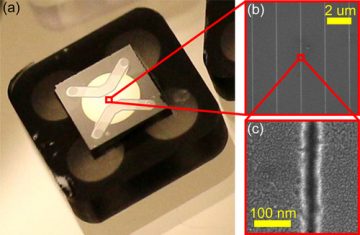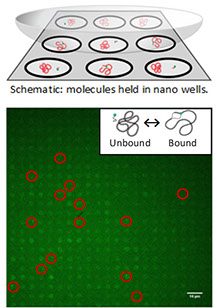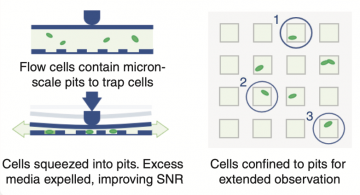“Seeing is Believing”
In the Leslie lab, we are shining new light on biology and biophysics using our unique imaging technology on state-of-the-art microscopes. By directly visualising how biomolecules interact with each other and with human cells and tissues, we can make new discoveries about fundamental biological processes and learn how to design better vaccines and genetic medicines to prevent and treat a range of diseases.
Summaries of some of our main research themes are presented below. Please see our publications page for further details.
Convex Lens-induced Confinement (CLiC) imaging platform
Our unique imaging platform, invented by Dr. Sabrina Leslie, is called Convex Lens-induced Confinement, or CLiC. This technology can visualise and measure single molecules without the need to tether them to hard surfaces, which allows us to track in real time how the molecules move and interact in more realistic models of human cells and tissues. Understanding these dynamics is key to the design of improved vaccines and drugs.

(a) Fabricated chip glued to a custom plastic carrier to facilitate clamping for use with short-working-distance objectives.
(b) and (c) Scanning electron micrographs of nanogrooves etched into the glass.
DNA, RNA, and other biopolymers
The CLiC imaging platform can quantify DNA and RNA molecules and other biopolymers, track their movements over time in confinement and in cell-like environments, and reveal details of their structures. We are using these insights to, for example, understand how genes are regulated in normal and cancer cells, to improve long-read DNA sequencing and biomarker detection assays, and to understand the biophysics of biopolymers in living cells.

Biomedical applications: vaccines and genetic medicines
We are working with academic experts and biotechnology companies to use our unique imaging technology to solve some of the problems that act as bottlenecks in the clinical development of lipid nanoparticles, RNA vaccines, and genetic medicines. For example, we’re studying how genetic medicines based on antisense oligonucleotides can be designed to effectively target and shut down specific genes that cause certain diseases. We are also working to understand how the lipid nanoparticle (LNP) and RNA components of vaccines (including COVID-19 mRNA vaccines) interact with each other and with human cells. Our goal is to help vaccine and drug developers design improved formulations that are safe, more effective, and easier to store and distribute equitably to address global health needs.


Facilitating real-world applications of our unique imaging technology
With support from NSERC’s Idea-to-Innovation program, we have created an early-stage spin-out company called ScopeSys to facilitate the translation of our CLiC platform to real-world applications. Rapid advances in our field are creating entirely new opportunities to visualize biological and biophysical processes at single-molecule resolution, and we are excited to work with industry partners to find new applications of CLiC in diagnostics, therapeutics, and beyond.